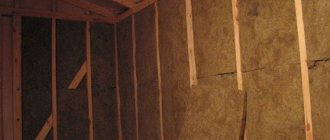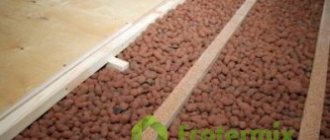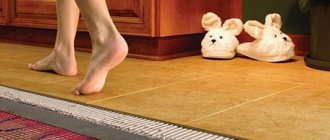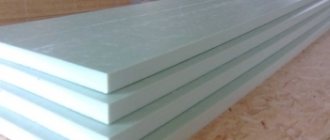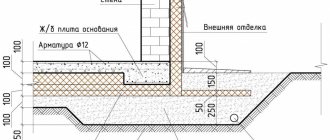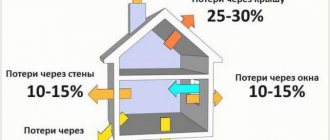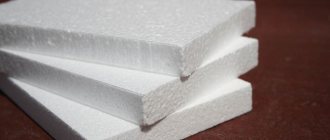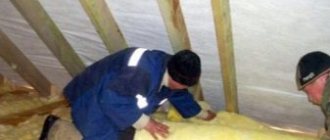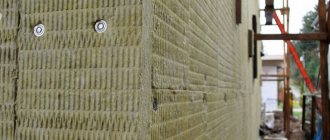Features of insulating the basement ceiling of an apartment building
All of the above is true for a private cottage.
How realistic is it to insulate the floor from the basement side of an apartment, so as not to spoil the newly renovated floor and not limit yourself in the thickness of the insulation layer (especially important for apartments with low ceilings)? A basement in an apartment building is not your personal property. In some cases, even entering there is problematic: it is locked with a key, and the technician-caretaker has the key. To carry out work there, you will need permission from the housing administration. Responsible housing and communal services officials will tell you which documents to collect.
The list will likely include a permit from the fire inspector.
note
Therefore, do not rush to purchase PPS or PPU - they are flammable, the likelihood of getting the go-ahead from firefighters is minimal.
Pay attention to basalt wool and foam glass in slabs: both materials belong to the NG group. Serious disadvantages of mineral wool:
Serious disadvantages of mineral wool:
- hygroscopicity;
- when wet, cotton wool loses more than half of its heat-shielding properties;
- vapor permeability.
This is not critical if the basement is dry and well ventilated.
Mineral wool insulation of a basement ceiling from the inside can be done in two ways, frameless and framed. In the first case, installation is carried out similarly to the PPS:
secure the slabs to the ceiling with glue;
secure with “umbrellas”;
plaster with façade plaster reinforced with fiberglass mesh.
This option is feasible only with rigid facade slabs and only in a dry basement. In other cases, a frame one is used:
1. The ceiling is sheathed with plasterboard profiles.
2. Cotton wool is placed between the profiles.
3. Cover with a vapor barrier membrane.
4. Sew up with waterproof plasterboard, fiberboard sheets or other similar material.
Sometimes mineral wool blanks are hermetically packaged in plastic or vapor-proof film before being placed in the frame and the seams are sealed with mounting tape.
The option is energy-intensive, but provides 100% protection of the insulation from getting wet.
Another option is to insulate the ceiling in the basement of the house with foam glass slabs.
This material does not absorb moisture and is alkali-resistant - an important property when used in combination with plaster.
Its disadvantages:
- the weight is on average three times greater than that of mineral wool;
- much higher price.
The maximum permissible thickness of thermal insulation is 10 cm. Within these limits, you can fasten the slabs with glue and dowels with nails in increments of 20 cm. If it is more, you will need a frame, but it should be taken into account that foam glass will create a large load on the floor.
When installing with glue, the slabs are treated from the outside with plaster and fiberglass mesh; when using the frame method, they are sewn up with waterproof sheets.
Choosing a method for insulating the foundation from the inside
When choosing a method, you need to focus on several factors:
- Construction of the building, dimensions of the basement or semi-basement;
- The presence of external insulation and temperature conditions on the outside of the foundation;
- Soil type and location of groundwater;
- Required temperature conditions in the basement after insulation, availability of heating and ventilation;
- The need for further decorative finishing.
A cheap method of internal thermal insulation of the foundation is to fill the space under the floor with expanded clay. This material removes water and creates an air cushion that protects the floors of the first floor from cooling. You can fill in both the entire space under the floor and the formwork installed on the inside at some distance from the foundation walls.
If the basement is used to house household premises, and its walls need not only insulation, but also finishing, it is advisable to use polystyrene or penoplex boards, which allow creating a smooth coating ready for cladding. In this case, the highest quality and most durable will be the insulation of the foundation both from the outside and from the inside - by eliminating the temperature difference, you can avoid the formation of condensation on the internal walls of the basement. If insulation from the outside is not possible, it is necessary to perform penetrating waterproofing of the foundation: concrete treated in this way is not subject to freezing, but retains vapor permeability, reducing humidity under the insulation slabs. It is also necessary to arrange supply and exhaust ventilation, since these materials do not allow moisture to pass through.
If funds allow, you can choose thermal insulation with polyurethane foam - this method is effective and suitable for any basement.
Useful tips
If you decide on external thermal insulation of the basement, a few tips will be useful for you that will help increase the efficiency of the measures taken:
It is better to carry out insulation in dry and clear weather. Especially if instead of EPS you use regular foam, which is less resistant to moisture. Never neglect waterproofing
This operation not only prevents damage to the insulating material, but also protects the foundation and walls of the basement from destruction. When choosing a mastic with which you are going to glue foam or EPS, pay special attention to its hydrophobic properties. And do not apply it pointwise (as I described for interior work), but in a continuous layer
Then it will play the role of another waterproofing agent. The edge of the glued insulation material must rise above the ground level (after backfilling) by at least 50 cm.
A basement like this is everyone’s dream.
Preparing the ceiling surface for insulation
First of all, you need to prepare the base ceiling. The surface is cleaned of dust and cobwebs, cracks are covered, unevenness and other defects are eliminated. Since foam plastic can only be glued to a flat surface, it is worth checking the height difference on the ceiling. If it is significant, then foam plastics are also mounted on a supporting frame.
To eliminate defects and unevenness on a wooden base ceiling, wood putty is used, and when working with concrete surfaces, cement-based leveling mixtures are used. When the repair mixture has dried, the surface is sanded and impregnated with antiseptic primers, as well as deep penetration compounds if an adhesive installation method is used.
Internal insulation
Any type of expanded polystyrene is most often used precisely to insulate the basement from the inside. Here there are some features for each of the available surfaces: ceiling, floor and walls.
Floor insulation with polystyrene foam
Since installing heated floors in the basement is not the most common event, more traditional methods of insulating the basement from the foundation side are most often used.
To insulate the floor in the basement, you only need a few steps:
- Level the surface.
- The insulation layer must have a certain thickness and fit tightly to each other at the joints. It is optimal to use 5 mm thick material for the floor.
- It is necessary to lay a layer of polystyrene foam on top of the expanded polystyrene slabs.
It is better to insulate the floor in the basement using an additional reinforced screed on top of the insulation layer.
insulation with polystyrene foam
Wall insulation
Insulating the basement walls from the inside helps maintain the temperature in the room. In addition, to avoid condensation accumulation in the basement, it is very important to use high-quality waterproofing materials. This will ensure long service life of the thermal insulation and prevent the destruction of the structure as a whole.
Next, polystyrene foam boards are attached on top of the material chosen for waterproofing. Glue is usually used for fastening. After all the walls are covered with slabs and the glue has dried, additional work is carried out on the surface of the basement walls.
A concrete screed is used to strengthen the structure. To create it, it is recommended to purchase M100 cement and use additional reinforcement. Do not be too zealous; the screed layer should not be too thick.
Since any basement has high humidity, an additional layer of waterproofing material will not be superfluous, but this item is optional. After insulation with polystyrene foam materials, the surface can be covered. For this, you can use various materials, it all depends on the budget and wishes of the owner.
Important! Not a single joint of the thermal insulation material should protrude, since these are the places that are most vulnerable to the formation of condensation.
Ceiling insulation
The technology for insulating a cellar lid with polystyrene foam is not too different from other surfaces, but has some features.
Important! The ceiling is the part of the cellar that is most susceptible to condensation accumulation. Before installing insulation on the basement ceiling, you need to pay special attention to the waterproofing layer.
All insulation work is carried out in several stages:
- Surface preparation. It is necessary to eliminate all cracks and gaps that may be on the ceiling. In addition, if dowels are used for installation, it is necessary to think about their insulation, since a small amount of cold can penetrate through the fasteners.
- Vapor barrier. After the ceiling surface is leveled, it is necessary to additionally use a layer of vapor barrier material. This is necessary to ensure that condensation does not form during operation of the room. It is best to use a layer of penofol, as it has additional heat-insulating properties.
- Installation of hangers. Hangers are necessary for further installation of sheathing profiles. Careful measurements must be taken to ensure that the distance between the profiles exactly matches the dimensions of the slabs.
- Installation of slabs. This is the most important stage. It is also important to avoid gaps here. In addition, it is recommended to additionally insulate the joints using construction foam.
- Additional layer of vapor barrier. Additional vapor barrier is not mandatory, but is recommended to create an optimal indoor microclimate. It is very important that the distance between the polystyrene foam and the vapor barrier layer is at least 40 mm, this will create additional ventilation between the layers and reduce the possibility of condensation accumulation.
Footer care rules
As mentioned above, footer is a fabric that is not at all fancy in everyday life. But still, I advise you to follow a few simple rules in order to extend the life of your favorite things:
- When washing, use the delicate cycle;
- The optimal water temperature for washing items made from footer is 30 degrees;
- To avoid damage to the fabric by the fittings, it is better to turn the product inside out before washing, while fastening all the buttons or zipper;
- Do not use high speeds when spinning;
- Do not leave clothes to dry in the sun for a long time, otherwise the fabric may be damaged by sunlight;
- It is recommended to wash children's clothing with soft, gentle powders;
- Iron the footer from the inside out.
Practical tips for creating high-quality insulation
The quality indicator of the insulation work performed will depend not only on the type of insulator used, but also on the technique of its installation. The maximum effect when laying mineral wool can only be achieved if the following conditions are met:
- The rough coating layer, consisting of a mixture of sand and cement, must be laid as evenly as possible and compacted thoroughly.
- The material for waterproofing can be roofing felt or polyethylene film.
- If the insulation boards are located in the same horizontal plane, without noticeable gaps between them, additional sealing of the joints will not be necessary.
- It is necessary to place a thin layer of screed on top, reinforce it with a galvanized mesh and fill it again with concrete mixture. You can use foam concrete, since it has less weight compared to the standard composition.
- Laying the flooring can only be done after the concrete has completely gained strength and dried.
Basement insulation from outside
Insulation of basement walls from outside
Recommendations and procedure for performing work:
- work is carried out only in dry weather and during the warm season. This guarantees minimal soil moisture near the foundation;
- Insulation work begins with excavation of soil near the foundation;
- then the foundation is inspected for the presence of cracks, peeling of waterproofing materials, significant irregularities, etc.;
- The first layer of waterproofing is applied. Experts recommend applying moisture-repellent mastic and applying it in a continuous layer;
- insulation is installed.
For external insulation of the basement, it is preferable to use polystyrene foam or polyurethane foam. Because These materials are distinguished by reliable adhesion to each other and long service life. The insulation is mounted in such a way that it is 500 mm. protruded above the foundation (above ground level). An important feature: when installing the insulation, umbrella dowels are not used, but only an adhesive solution. The solution is applied with a notched trowel, which makes it possible to evenly apply the adhesive to polystyrene foam or polyurethane foam and avoid the appearance of voids under the sheet. Also, the use of glue will prevent damage to the sheet. If there are gaps between the sheets, they are filled with foam;
- a second layer of waterproofing is applied. It is important to apply this layer to the surface of the insulation, which will be located in the soil;
- a drainage system is being installed. Drainage around the house is needed to ensure that water does not stagnate near the insulation;
- decorative design of the base (for example, plaster, siding).
How to insulate basement walls from the outside
Note. Installation of insulation from the outside is a mandatory component of the work on insulating basement walls. Because installing insulation inside the basement at high humidity will lead to the foundation being destroyed by water acting from the outside.
Types of thermal insulation materials
Insulation of the ceiling in the basement can be done using mineral wool, polystyrene foam or extruded polystyrene foam, which differ in technical characteristics and installation nuances.
Mineral wool
Mineral wool
is compressed fibers of inorganic material, the layers of which are molten rocks, blast furnace slag and fiberglass. Mineral wool based on sedimentary rocks is used to insulate basement ceilings. It is different:
- good insulating properties;
- low thermal conductivity;
- resistance to fire and chemicals.
The lifespan of the material is about 30-40 years.
Polystyrene foam and extruded polystyrene foam
Styrofoam
Insulation materials are made from polystyrene using different technologies, so some of their parameters have significant differences. Common benefits include:
- light weight;
- low thermal conductivity coefficient;
- ease of installation and maintenance.
Extruded polystyrene foam is more effective as thermal insulation than polystyrene foam, but is more expensive. The main disadvantage of these materials is the disruption of the natural balance of temperature and humidity in the premises, which occurs due to the lack of circulation of moisture and air. To maintain a comfortable microclimate, it is necessary to ensure good ventilation.
Insulation of the cellar from the inside
The main difference between a cellar and a basement is location. The cellar is usually located near the main building and, accordingly, does not have protection from external weather factors above it in the form of a double warm ceiling.
This fact must be taken into account when insulating the cellar from the inside. If the insulation of walls and floors does not differ from the insulation in the basement, then the ceiling needs to be insulated from cold in winter and heat in summer more thoroughly.
To insulate the ceiling in the cellar, it is advisable to use slabs of polystyrene foam, penoplex or expanded polystyrene. The total thickness of thermal insulation must be at least 20 cm.
The insulation process is as follows:
- Treatment of floor slabs with waterproofing material.
- Gluing 2 layers of insulation onto glue in a cross way, sealing the cracks with polyurethane foam. The thickness of each layer of insulation is at least 10 cm.
- Gluing the surface of the insulation with glue using reinforcing mesh.
If you don’t plan to cover the resulting “pie” with anything, then you can stop there. If the ceiling is hidden under the finishing made of sheet materials, it is necessary to add a layer of vapor barrier between the sheathing and the insulation.
If it is impossible to insulate the basement from the outside, you can carry out heat insulation work from the inside. With proper selection and installation of materials, such insulation will be comparable to external insulation.
When carrying out work, you must remember that the basement is a room with a very aggressive environment, and, accordingly, use high-quality materials. By following insulation technology, you can achieve good results and the house will become warm and cozy, and will also add a lot of free space.
How to make a dry basement and cellar with your own hands, watch the video:
Thermal insulation of any basement is one of the most important points, since it allows you not only to maintain the temperature, but also to avoid the formation of condensation, which leads to the destruction of the structure. Insulating a basement with penoplex or polystyrene foam has many advantages, which is why it is becoming increasingly popular compared to other methods of thermal insulation. But it is worth considering that these materials have their own characteristics, which are very important to take into account. It is necessary to carefully read the instructions, since insulating the basement with polystyrene foam, and doing it correctly, can only be done in compliance with the technology.
wall insulation
Insulating the basement of a house from the inside
If the foundation is not insulated during construction, then external insulation becomes a very labor-intensive task. Therefore, insulation is most often done from the inside. In an insulated and unheated basement, the temperature remains within +10 degrees even during frosty periods. Accordingly, heat is better retained in the house itself. There is also a minus - interior decoration with heat-insulating materials reduces the usable area of the room.
Insulation of basement walls from the inside
Insulating the basement from the inside in a private house or apartment building can fully provide adequate protection from humidity and cold. But we must remember that the use of waterproofing material is mandatory, otherwise condensation will penetrate into the insulation and not only worsen its thermal insulation characteristics, but also completely destroy it.
The order of work is as follows:
- existing damage on the walls is covered with sealant or blown out with foam;
- the surface of the walls is leveled as much as possible so that the insulation boards lie flat;
- the walls are treated with waterproofing material (mastic or liquid rubber);
- lay the insulation boards using an adhesive mixture;
- laying begins from the bottom, tightly joining the slabs;
- all cracks are filled with polyurethane foam;
- the slabs are secured with dowels for reliability (5 pieces for each slab);
- after the glue has dried, a screed is made using a mesh and a cement mixture;
- Finally, the wall is covered with finishing material.
Proper insulation of an unheated basement from the inside will provide protection from moisture and cold
Insulating the basement ceiling from the inside
The ceiling in the basement is a concrete floor, which conducts both heat and cold well. The insulated ceiling of the basement will always ensure a warm floor in the house.
Stages of work on insulating the ceiling in the basement:
- the concrete ceiling is covered with a water-repellent layer (mastic, rubber), which at the same time closes all cracks in the concrete;
- after the waterproofing has dried, insulation boards are glued and secured with dowels;
- a special mesh is applied to the fixed insulation using a cement mixture;
- final decorative finishing is carried out.
How to insulate a ceiling in a basement and what material is best suited for this will be discussed below.
It is not recommended to insulate the ceiling without waterproofing
How to properly insulate the floor in the basement of a house
The process of insulating a basement floor is easier than insulating walls or ceilings. If it is not yet equipped, then insulation of the basement floor is carried out directly on the ground in the following order:
- the soil surface is leveled;
- a layer of sand is poured and compacted;
- a layer of crushed stone is poured and also compacted;
- filled with liquid concrete;
- after drying, a waterproofing layer is laid overlapping;
- insulation boards are being laid;
- You can lay a layer of penofol (thin rolled material) on the insulation with the foil surface up so that this film reflects heat;
- the reinforcing mesh is laid and everything is filled with concrete;
- After drying, you can install the floor covering.
If the floor has already been concreted, then the task is easier, and the work begins with laying waterproofing.
A waterproofing layer is laid on top of the screed
In cases where the floor is built on joists, the first step is to remove the top finishing coating. Considering that the waterproofing should already be laid under the joists, you can pour expanded clay or lay insulation boards between them. Then the entire structure is covered with another layer of vapor barrier (simple film, for example) and a final floor covering is installed.
Related article:
If there is a utility room in the basement, then floor insulation is not necessary. In the case when the basement is insulated in order to equip a functional room in it, then the question of whether to insulate the floor in the basement requires a positive answer.
In a private house
It is not difficult to do the insulation of basement walls in a private house with your own hands. The main thing is to choose the right material and follow the instructions.
If heating or water supply systems pass through the basement floor, but there is no external thermal insulation of the perimeter, the pipes must be insulated. Basic requirements for insulating heating pipes in the basement:
- ease of installation;
- low thermal conductivity;
- resistance to wet environments;
- self-extinguishing ability;
- environmental cleanliness.
You can insulate pipelines in the basement with the following materials:
- Rolled mineral wool. The most inexpensive and inconvenient material to use. Installation is carried out in the following order:
- cut a piece of material of the required size;
- wrap the pipe with insulation;
- secure the thermal insulation with a nylon rope.
- Shell made of polyurethane foam or polystyrene foam. Such materials are produced in different formats, so when purchasing, you need to consider the diameter of the pipe. Installation is carried out in several stages:
- fix the shell halves on the pipe;
- secure the insulation with tape;
- Attach the following insulation elements with an overlap of 10-20 cm so that there are no gaps.
- Foamed polyethylene tube. This type of insulation can be used when installing a water supply system, then the insulation will be seamless. The main advantage of this material is that it does not need waterproofing. Installation is carried out as follows:
- if the system is already installed, the material must be cut to length and wrapped around the pipe;
- secure the insulation with plastic clamps and seal the joint with aluminum adhesive tape.
After such insulation, you don’t have to worry about the pipeline even in the most severe frosts, but insulating the walls in this situation will not be superfluous.
In the garage
Not long ago, an innovative insulation technology using heat-insulating paint appeared on the building materials market. The thickness of such a coating is only 5 mm, which is a definite plus when insulating rooms with a small cubic capacity), but it can replace 1.5 m of brickwork. Insulating paint is also unique in that it not only does not allow heat to pass through itself, but also plays the role of a reflector. This material is ideal as insulation for a garage basement.
If until now the question was how best to insulate the basement in the garage, now the answer is obvious.
In an apartment building
Heating networks, as a rule, pass through the basement floors of municipal buildings. Thermal insulation of pipes in the basement of an apartment building, as well as protection from the cold of the entire building, are under the control of housing and communal services.
Information on how to insulate a basement in a private residential house, garage or cellar is not a military secret. More detailed materials on this topic can be found on the Internet. Making thermal insulation of a basement with your own hands is not so difficult, especially if you have the skills to use the necessary tools.
Which insulation materials to choose for insulation
An important stage in the internal insulation of a basement, especially when it comes to walls and ceilings, is the selection of insulation. The final result will depend on how high quality it is (we are talking about the coefficient of thermal conductivity and resistance to moisture).
There are many options for insulation on the market, including those suitable for internal insulation. Below are the most proven and accessible of them.
Polystyrene foam is the most budget option, but has a serious drawback - lack of resistance to mechanical damage and extremely low or high temperatures. The material has been used for thermal insulation for several decades, being preferred primarily due to its affordable price.
To insulate the basement, polystyrene foam is used only if there are no other options. The insulation will not be able to reliably protect surfaces from cold and moisture, and therefore will require additional vapor-waterproofing to avoid premature wear.
Another option is penoplex. The material is more convenient and effective for a private home than the foam described above, but will cost more. They install penoplex in the form of slabs according to the described algorithm, not forgetting about the cold “bridges” that are inevitable with a careless approach to the processing of joints.
To achieve maximum results, penoplex for internal insulation is used in conjunction with more advanced thermal insulation for insulating walls outside, for example, polyurethane foam.
This material is resistant to mechanical damage and proves itself to be a modern insulation worthy of respect and trust. The disadvantage of the material is the complexity of installation. To apply insulation you will need a special installation operating under high pressure.
Among the advantages, it is worth highlighting persistent protection from moisture without the need to install an additional layer, room tightness, and biological neutrality.
Expanded polystyrene, an example of modern thermal insulation with properties similar to penoplex, can also be a suitable option for insulating a private home.
Insulation thickness
In order for the insulation of the basement from the inside to be sufficient for the minimum level of heat loss, the thickness of the insulation should be:
- 10 centimeters for polystyrene foam;
- 8 centimeters for polyurethane foam.
But it is recommended to increase this value by 40 - 50% if the basement is supposed to be heated and maintain a temperature of 20 - 25 degrees in order to reach the recommended level of thermal insulation.
How to insulate a basement yourself
To insulate the basement from the inside yourself, you can only choose extruded polystyrene foam. This insulation is relatively expensive. But cheap polystyrene foam is not applicable in the basement, due to the fact that it can gradually become saturated with moisture.
Processes for insulating a basement from the inside:
- the existing plaster is removed, the wall is cleaned of dust;
- the wall is impregnated with a water repellent;
- the wall is leveled, if necessary, with foam glue or strong (comparable to concrete) cement-sand mortar; Expanded polystyrene sheets are glued to the wall. The glue is applied to the wall with a notched trowel, the sheets are applied and tapped with a mallet, and when joining, the seams between the sheets are coated with sealant.
Only sheets of expanded polystyrene butted into a groove are used. The surface of the glued sheets is leveled with a float if necessary. Decorative plaster is applied on top of the polystyrene foam or a false wall is built on top of the insulation.
Materials for basement insulation
First, the home owner must decide how to insulate the basement. There are many types of thermal insulation materials with very different characteristics on the construction market.
Let's consider the most popular insulation materials from the point of view of the feasibility of using them for thermal insulation of a basement:
- Styrofoam .
The cheapest and most accessible insulating material. For insulation, foam plastic with a density of 25 kg/m3 is used. Foam plastic is popular due to its properties: lightness, resistance to rotting, excellent thermal insulation characteristics, inability to absorb moisture, long service life. That is why insulating the basement with polystyrene foam is one of the most common ways to increase the thermal insulation characteristics of the basement. But we should not forget that polystyrene foam cannot be used in rooms with a high risk of fire in order to eliminate the possibility of a fire. This material is flammable and, most importantly, releases harmful toxic substances when burned;
- expanded polystyrene .
A more modern analogue of polystyrene foam. It has all the properties inherent in polystyrene foam, but is distinguished by a higher density (and therefore stronger), and the presence of a tongue-and-groove system. At the same time, expanded polystyrene is characterized by ease of mechanical processing (the sheet does not crumble when cut), resistance to stress and a higher price. Basement insulation with polystyrene foam is actively practiced because... this material is best suited for insulating the basement from the outside and inside;
- polyurethane foam . Sprayed thermal insulation material. The peculiarity of polyurethane foam is its ability to fill the smallest cracks. Polyurethane foam does not allow moisture to pass through, does not rot, does not burn, and ensures complete tightness of the room. Insulating the basement with polyurethane foam allows you to create a durable outer layer of insulation. Disadvantages include high cost and the inability to do the work yourself;
- mineral wool . Insulating the basement from the inside allows the use of soft insulation materials and only in the absence of moisture. Mineral wool is hygroscopic and, when wet, loses its thermal insulation properties;
- expanded clay Despite the fact that this is a bulk insulation, it has good thermal insulation properties. However, insulating a basement with expanded clay is only justified to insulate the floor in the basement and to protect the foundation from the outside, since expanded clay gravel (crushed stone) provides good drainage.
The insulation, its type and thickness, is selected individually for each specific case. The choice of thermal insulation material can be entrusted to a professional who will calculate the required thickness taking into account many factors. Or you can do the calculation yourself. To do this, you can use the recommendations that contain:
- SNiP II-3-79 “Construction heating engineering”
- reference book on heat and sound insulation designs. Basement walls and foundations;
- SNiP 23-02-2003 “Thermal protection of buildings”
And:
Thermal requirements for basement insulation
Studying the above documents makes it possible to highlight the main thermal technical requirements:
- heat transfer resistance (SNiP 23-02-2003). For Moscow – Ro = 4.15 m2•°C/W.
Dependence of the thermal conductivity coefficient of insulation and its thickness for internal basement insulation (table)
Dependence of the thermal conductivity coefficient of insulation and its thickness for external basement insulation (table)
- load perception (SNiP 2.01.07-85);
- heat resistance of the enclosing structure. Calculation of the amplitude of temperature fluctuations is based on the provisions of SNiP 23-02-2003;
- vapor permeability of the enclosing structure (SNiP 23-02-2003).
- fire safety requirements (SNiP 21-01-97, GOST 30247, GOST 30403).
The selected material leaves a significant impact on the choice of technology and determines what and how to properly insulate the basement in a private house.
Properties and types
kulirka-s-laykroy-2 kulirka-s-laykroy-1
A cooler with lycra has the same hygienic and physical properties as a classic one made of pure cotton:
- hygroscopicity. Capable of absorbing an amount of moisture equal to 15-20% of its own weight;
- breathability. In products made from this material, the body “breathes”;
- hypoallergenic. The material is made from environmentally friendly raw materials and does not cause allergies.
kulirka-s-laykroy-3 kulirka-s-laykroy-4
Physical properties:
- softness. Very pleasant to the touch and does not cause skin irritation;
- strength and durability. Products made from it do not tear and last a long time;
- firmness and elasticity. It stretches well and returns to its original shape, practically does not wrinkle.
Thanks to the addition of elastane fibers, the mechanical strength and elasticity of the fabric increases; items made from it are shape-resistant: they stretch and completely restore their shape without stretching, and do not shrink after washing.
The disadvantages of the material include a strongly curled edge, which usually causes inconvenience when cutting and sewing; the edges of thin knitwear need to be processed in a special way.
Sometimes a certain percentage of polyester is added to cotton and elastane fibers, which reduces the hygroscopicity and softness of the fabric, adding strength and wear resistance to it. This material is cheaper than natural material. When choosing products, it is recommended to take into account the composition and choose those in which the polyester content does not exceed 20%.
The canvas fabric lends itself well to dyeing, prints perfectly on it, and can be plain-dyed or printed.
Depending on the length and quality of the threads used, there are several types:
- singing - made from threads 35-70 mm long and is the most expensive and high-quality. This material does not form pills, it does not shrink, and printed designs fit perfectly on it;
- cardier or ring - has a coarser texture than pene, made of threads of shorter length (up to 35 mm);
- Open end knitwear is made from the shortest threads and is considered the lowest in quality. Pellets may form on the surface.
Types of polystyrene
As already mentioned, penoplex and polystyrene foam are types of polystyrene, which differ slightly in characteristics and production technology. Very often you can find the terms foamed and extruded polystyrene foam, where the first means foam plastic, and the second penoplex.
Foamed polystyrene foam is produced without forced pressure injection. The resulting material is quite fragile and is able to absorb moisture. In addition, when using it in basements, there is a possibility of encountering vermin such as rats and mice. However, the material has a wide range of applications due to its low cost.
To create penoplex it is necessary to use high pressure and temperature. This material has low vapor permeability, but is characterized by high density, which allows it to be used as insulation in structures that are subject to high mechanical loads. Despite its density, penoplex is very easy to process, which greatly simplifies the installation process.
Options for basement insulation with polystyrene foam and penoplex are considered the most acceptable and common; the choice will depend solely on the customer’s budget.
polystyrene type
Types of basement insulation
Basement insulation can be done in several ways:
- internal insulation . Simpler, but requires work to eliminate moisture, otherwise the appearance of condensation will negate all insulation;
- external insulation . Allows you to prevent freezing of the wall from the outside. This method of thermal insulation is more rational, because provides better protection and does not reduce the usable space of the room, but it is more labor-intensive. As a rule, it is performed during the construction stage of a house;
- combined insulation . It is the most effective because it includes the installation of thermal insulation material and waterproofing of the basement on both sides.
The choice of method is determined by factors such as:
- humidity conditions;
- presence of heating in the basement;
- the presence of a drainage system around the basement;
- purpose of the basement.
Features when working with acrylic paints
Acrylic paints are an inexpensive material that is easy to work with and dries relatively quickly. But the disadvantage is the narrow palette of colors, so you need to create the desired shade manually. You can get burgundy, lilac, turquoise, sand, wenge, lilac, and others by mixing colors.
Mixing colors
There are some rules when working with acrylic:
- The surface to be painted must be smooth, clean, free of oil and grease stains. It must first be cleaned of the previous finish. It is not recommended to apply a new coat of paint over an old one;
- Before painting, the walls need to be leveled with putty, and then several layers of primer must be applied. The primer is used for better adhesion of paint and for less paint consumption;
- Before use, acrylic must be diluted with water or special solvents, but it is better to do this in a separate container with a portion of paint. This is necessary in order not to spoil the entire volume at once, but to use only as much as needed.
- After use, used rollers and brushes must be rinsed thoroughly with water, otherwise they will become unsuitable for further work. You also need to wash other tools that were used. The top of the paint bucket needs to be wiped down so that the lid can be opened in the future.
- Most often, painting occurs in 2-3 stages, and for an effective result, this must be done in one direction. To simplify and speed up the work, you can take a spray bottle.
Important! Also, do not forget about precautions; before work, it is better to cover or seal all places and objects that will not be painted. You can work with the material at a temperature not lower than 5 degrees and not higher than 27 degrees
Another main rule of application is to use paint first on a small area or a completely separate surface. When creating the desired shade, it is better to try it on a draft. You also need to wait until it dries completely, as after that the color becomes a little darker or lighter, depending on the type of paint. And if the color matches the expected desired result, then you can start painting the surface or decorating objects.
